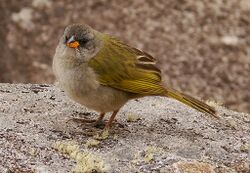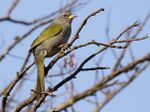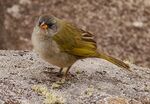Biology:Embernagra
| Embernagra | |
|---|---|

| |
| Pampa finch, Embernagra platensis | |
| Scientific classification | |
| Domain: | Eukaryota |
| Kingdom: | Animalia |
| Phylum: | Chordata |
| Class: | Aves |
| Order: | Passeriformes |
| Family: | Thraupidae |
| Genus: | Embernagra Lesson, 1831 |
| Type species | |
| Tanagra dumetorum[1] = Emberiza platensis Lesson, 1831
| |
| Species | |
| |
Embernagra is a genus of South American finch-like birds in the tanager family Thraupidae.
Taxonomy and species list
The genus Embernagra was introduced in 1831 by the French naturalist René Lesson with the Pampa finch as the type species.[2][3] The name combines the names of two genera: Emberiza introduced for the buntings by Carl Linnaeus in 1758 and Tanagra introduced for the tanagers by Linnaeus in 1764.[4]
This genus was traditionally placed with the buntings and New World sparrows in the subfamily Emberizinae within the family Emberizidae.[3] A molecular phylogenetic study published in 2014 found that Embernagra was embedded in the tanager family Thraupidae. Within Thraupidae Embernagra is now placed with Coryphaspiza and Emberizoides in the subfamily Emberizoidinae.[5][6]
The genus contains two species:[6]
| Image | Common Name | Scientific name | Distribution |
|---|---|---|---|
 |
Serra finch | Embernagra longicauda | Brazil |
 |
Pampa finch | Embernagra platensis | Argentina, Bolivia, Brazil, Paraguay, and Uruguay |
References
- ↑ "Thraupidae". The Trust for Avian Systematics. https://www.aviansystematics.org/4th-edition-checklist?viewfamilies=202.
- ↑ Lesson, René (1831) (in French). Traité d'Ornithologie, ou Tableau Méthodique. 1. Paris: F.G. Levrault. p. 465 (livraison 6). https://www.biodiversitylibrary.org/page/35997449. Published in 8 livraisons between 1830 and 1831. For dates see: Dickinson, E.C.; Overstreet, L.K.; Dowsett, R.J.; Bruce, M.D. (2011). Priority! The Dating of Scientific Names in Ornithology: a Directory to the literature and its reviewers. Northampton, UK: Aves Press. p. 119. ISBN 978-0-9568611-1-5. https://www.researchgate.net/publication/267763194.
- ↑ 3.0 3.1 Paynter, Raymond A. Jr, ed (1970). Check-List of Birds of the World. 13. Cambridge, Massachusetts: Museum of Comparative Zoology. p. 131. https://www.biodiversitylibrary.org/page/14483366.
- ↑ Jobling, James A. (2010). The Helm Dictionary of Scientific Bird Names. London: Christopher Helm. p. 145. ISBN 978-1-4081-2501-4.
- ↑ Burns, K.J.; Shultz, A.J.; Title, P.O.; Mason, N.A.; Barker, F.K.; Klicka, J.; Lanyon, S.M.; Lovette, I.J. (2014). "Phylogenetics and diversification of tanagers (Passeriformes: Thraupidae), the largest radiation of Neotropical songbirds". Molecular Phylogenetics and Evolution 75: 41–77. doi:10.1016/j.ympev.2014.02.006. PMID 24583021. https://digitalcommons.lsu.edu/cgi/viewcontent.cgi?article=3613&context=biosci_pubs.
- ↑ 6.0 6.1 Gill, Frank; Donsker, David; Rasmussen, Pamela, eds (July 2020). "Tanagers and allies". IOC World Bird List Version 10.2. International Ornithologists' Union. https://www.worldbirdnames.org/bow/tanagers/. Retrieved 20 November 2020.
Wikidata ☰ Q743740 entry
 |

